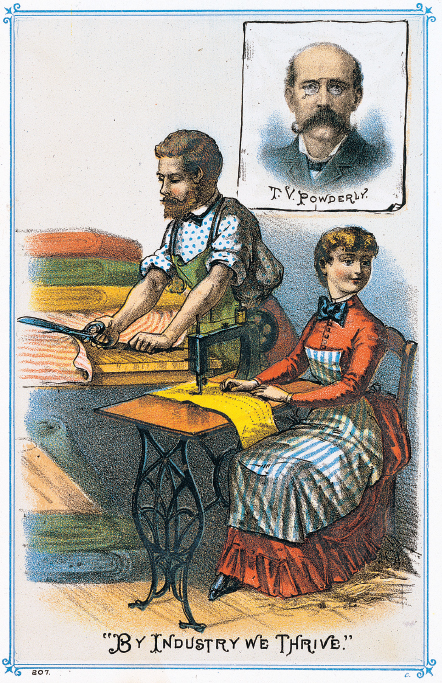America’s History: Printed Page 567
America: A Concise History: Printed Page 516
America’s History: Value Edition: Printed Page 499
The Knights of Labor

The most important union of the late nineteenth century, the Knights of Labor, was founded in 1869 as a secret society of garment workers in Philadelphia. In 1878, as the Greenback movement reached its height, some Knights served as delegates to Greenback-Labor conventions. Like Grangers, Knights believed that ordinary people needed control over the enterprises in which they worked. They proposed to set up shops owned by employees, transforming America into what they called a cooperative commonwealth. In keeping with this broad-based vision, the order practiced open membership, irrespective of race, gender, or field of employment — though, like other labor groups, the Knights excluded Chinese immigrants.
The Knights had a strong political bent. They believed that only electoral action could bring about many of their goals, such as government regulation of corporations and laws that required employers to negotiate during strikes. Their 1878 platform denounced the “aggressiveness of great capitalists and corporations.” “If we desire to enjoy the full blessings of life,” the Knights warned, “a check [must] be placed upon unjust accumulation, and the power for evil of aggregated wealth.” Among their demands were workplace safety laws, prohibition of child labor, a federal tax on the nation’s highest incomes, public ownership of telegraphs and railroads, and government recognition of workers’ right to organize. The Knights also advocated personal responsibility and self-discipline. Their leader, Terence Powderly, warned that the abuse of liquor robbed as many workers of their wages as did ruthless employers.
Growing rapidly in the 1880s, the Knights union was sprawling and decentralized. It included not only skilled craftsmen such as carpenters, ironworkers, and beer brewers but also textile workers in Rhode Island, domestic workers in Georgia, and tenant farmers in Arkansas. Knights organized workingmen’s parties to advocate a host of reforms, ranging from an eight-hour workday to cheaper streetcar fares and better garbage collection in urban areas. One of their key innovations was hiring a full-time women’s organizer, Leonora Barry. An Irish American widow who was forced into factory work after her husband’s death, Barry became a labor advocate out of horror at the conditions she experienced on the job. To the discomfort of some male Knights, she investigated and exposed widespread evidence of sexual harassment on the job.
The Knights’ growth in the 1880s showed the grassroots basis of labor activism. Powderly tried to avoid strikes, which he saw as costly and risky. But the organization’s greatest growth resulted from spontaneous, grassroots striking. In 1885, thousands of workers on the Southwest Railroad walked off the job to protest wage cuts; afterward, they telegraphed the Knights and asked to be admitted as members. The strike enhanced the Knights’ reputation among workers and built membership to 750,000. By the following year, local assemblies had sprung up in every state and almost every county in the United States.
Just as the Knights reached this pinnacle of influence, an episode of violence brought them down. In 1886, a protest at the McCormick reaper works in Chicago led to a clash with police that left four strikers dead. (Three unions, including a Knights of Labor assembly, had struck, but the Knights had reached an agreement and returned to work. Only the machinists’ union remained on strike when the incident occurred.) Chicago was a hotbed of anarchism, the revolutionary advocacy of a stateless society. Local anarchists, many of them German immigrants, called a protest meeting the next day, May 4, 1886, at Haymarket Square. When police tried to disperse the crowd, someone threw a bomb that killed several policemen. Officers responded with gunfire. In the trial that followed, eight anarchists were found guilty of murder and criminal conspiracy. All were convicted, not on any definitive evidence that one of them threw the bomb (the bomber’s identity still remains unknown) but on the basis of their antigovernment speeches. Four of the eight were executed by hanging, one committed suicide in prison, and the others received long sentences.

The Haymarket violence profoundly damaged the American labor movement. Seizing on resulting antiunion hysteria, employers took the offensive. They broke strikes with mass arrests, tied up the Knights in expensive court proceedings, and forced workers to sign contracts pledging not to join labor organizations. The Knights of Labor never recovered. In the view of the press and many prosperous Americans, they were tainted by their alleged links with anarchism. Struggles between industrialists and workers had created bitter divides.
IDENTIFY CAUSES
Question
What factors contributed to the rapid rise of the Knights of Labor? To its decline?